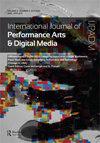后covid -19艺术世界:病毒戏剧、不稳定性和医学人文
IF 0.9
0 THEATER
International Journal of Performance Arts and Digital Media
Pub Date : 2022-09-02
DOI:10.1080/14794713.2022.2124769
引用次数: 0
摘要
在他们一份2021年的文章“病毒剧院”在《当代戏剧的英文会议之前,Liedke和Pietrzak-Franger描述的概念“病毒剧院”带来的运营、历史/传染性的理论概念在剧院,第二,21世纪的后现代社会的沉思病毒营销的条件,,第三,当前数字化的剧院(由于大流行)及其尝试上网“病毒”(129)。这三个方面激发了“后covid -19艺术世界:病毒戏剧、不稳定性和医学人文”项目的灵感。正如组织者提出的那样,其目标是在表演研究、文化研究和医学人文学科之间开展跨学科对话,以找出我们作为观众、学者和从业者如何体验和理解病毒戏剧。另一项努力是突出网络戏剧的创新实践,以及这些作品如何应对物质、经济和艺术不稳定的问题。会议将通过五个部分探讨这些问题,分别是“医学知识和媒体”、“COVID不稳定性和机构”、“COVID创造力”、“(后)COVID受众”、“边缘”以及关于“新挑战”的闭幕讨论。第一个小组介绍了戏剧可以通过改善人们的身心健康来治愈与世隔绝的人。简·麦克诺顿(Jane MacNaughton)强调了像大流行这样的健康危机如何使我们更加意识到文化与我们所体现的现实是如何纠缠在一起的,并强调了医学人文学科追踪这些发展的责任。艾米·威尔希尔(Amy Willshire)具有戏剧治疗的实践背景,她描述了即使在虚拟空间中,通过表演创造性地表达自己的可能性如何给她在封锁期间与之合作的年轻人一种自我意识。本文章由计算机程序翻译,如有差异,请以英文原文为准。
Post-COVID-19 art worlds: viral theatre, precarity and medical humanities
In their 2021 article on ‘ viral theatre ’ in the Journal of Contemporary Drama in English that preceded the conference, Liedke and Pietrzak-Franger describe the concept of ‘ viral theatre ’ to entail ‘ fi rst, historical/theoretical notions of contagiousness in theatre, second, 21st-century musings on virality as the condition of postmodern society, and, third, the current digitalization of theatre (due to the pandemic) and its attempts to go online and “ go viral ”‘ (129). These three aspects inspired the programme of ‘ Post-COVID-19 Art Worlds: Viral Theatre, Precarity and Medical Humanities ’ . The goal, as the organisers presented it, was to start an interdisciplinary dialogue between performance studies, cultural studies and medical humanities to fi nd out how we experience and understand viral theatre as audience members, scholars and practitioners. Another endeavour was to high-light innovative practices of online theatre and how these works respond to the issues of physical, economical and artistic precarity. The conference set out to explore these issues within fi ve sections entitled ‘ Medical Knowl-edge and Media ’ , ‘ COVID Precarity and Institutions ’ , ‘ COVID Creativity ’ , ‘ (Post)-COVID Audiences ’ , ‘ On the Edges ’ and a closing discussion on ‘ New Challenges ’ . The fi rst panel presented theatre as potentially healing for people in isolation by improving their physical and mental health. Jane MacNaughton underlined how a health crisis like the pandemic makes us more aware of how entangled culture and our embodied reality are and stressed the responsibility of the medical humanities to trace these developments. Coming from a prac-tical background of drama therapy, Amy Willshire described how, even in the virtual space, the possibility to express themselves creatively through performance gave a sense of self to the young people she worked with during lockdown.
求助全文
通过发布文献求助,成功后即可免费获取论文全文。
去求助
来源期刊

International Journal of Performance Arts and Digital Media
Arts and Humanities-Visual Arts and Performing Arts
CiteScore
1.70
自引率
0.00%
发文量
29
 求助内容:
求助内容: 应助结果提醒方式:
应助结果提醒方式:


